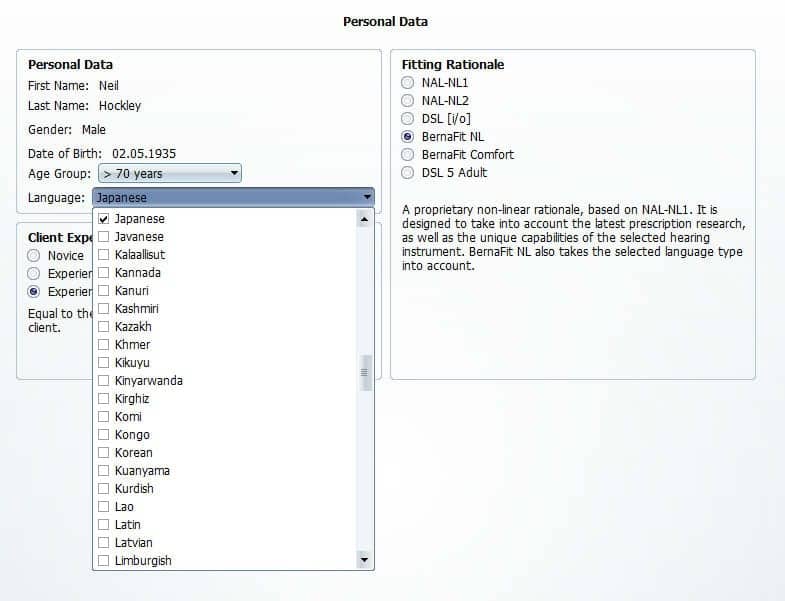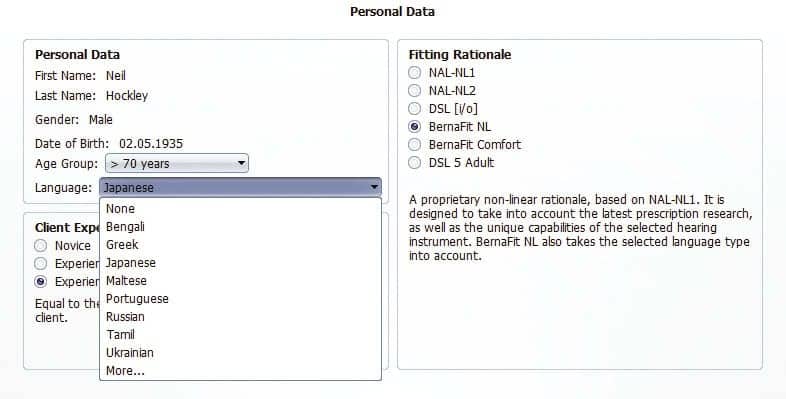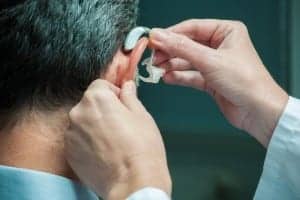By Marshall chasin, AuD, and Neil S. Hockley, MSc
There are subtle linguistic differences between many of the world’s languages that are not taken into account by the language-specific SII or the LTASS. The new Language Specific Targets implemented by Bernafon’s Oasis fitting software are designed to address this by applying linguistic factors in the prescription process that are not typically represented by the LTASS. This approach is designed to make the speech cues that differentiate many of the world’s languages accessible to non-English speaking or multilingual individuals.
One of the most salient, but least studied, issues in hearing health care is the clinical ramification for many clients who either do not speak English or have English as a second or even as a third language. Clinical questions arise regarding whether a hearing aid programmed for English should be set the same or differently when fit to a client whose first language is not English. There has been some recent published work suggesting that there may in fact be some linguistic aspects of a language that need to be taken into account in the prescription process.1-7 One example is the modification for tonal languages (eg, Chinese) used by the NAL NL2 fitting rationale, where different meanings can be gathered from pitch changes in the low-frequency vowels.8,9
Hearing instrument fittings are mostly based on the Long Term Average Speech Spectrum (LTASS).10-12 The LTASS is the representation of the level and frequency components of speech. Languages of the world all have a similar LTASS. Byrne et al12 examined the LTASS of 12 languages and several dialects and concluded:
The LTASS was similar for all languages…A “universal” LTASS is suggested as being applicable, across languages, for many purposes, including use in hearing aid prescription procedures.…[p 2108]12
This is not surprising because all languages around the world are uttered by humans who all have similar vocal tract dimensions with similar acoustic outputs. However, as will be shown, this is not the parameter that needs to be examined when determining frequency response and compression changes from English.
Of greater importance than the LTASS is the phonemic or linguistic property of a language that is meaningful to a speaker of that language. For example, in Russian, all sounds can be palatalized or not, and this changes the meaning of words, which is not the case in English. Palatalization has a phonetic cue in the 3000 Hz region (around the third formant). Russian speakers would require more gain at 3000 Hz when listening to Russian, as opposed to listening to English. Some of these cues are visible in the Speech Intelligibility Index (SII)13 and some others are not. SII differences will yield changes in the frequency response only, but do not provide any information on the compression time constants or the amount of gain required for soft level inputs, both of which can vary dramatically from language to language.
Language-specific changes have been previously described by Chasin,1,3-6 and can be summarized using the following three categories:
1) Languages with tonal, morae-timed, or low-frequency nasals/vowels. Languages that are tonal (eg, Chinese), are morae-timed (eg, Japanese), or have a proliferation of low-frequency nasals and vowels (eg, Portuguese) require more low-frequency gain than for English. These frequency response changes also can be seen in Semitic languages (eg, Arabic and Hebrew), but, in these cases, there should be more high-frequency gain than an equivalent setting for English due to the proliferation of linguistically distinctive high-frequency consonants.
These linguistically distinctive language characteristics will only result in frequency response changes and all can be observed by the language-specific SII. The information in Table 1 has been adapted from Chasin,1 and shows some cases where modifications may be necessary in various frequency regions, along with some language examples.

|
| Table 1 (click to enlarge) |
2) Languages with a rigid morphological structure requiring consonant-vowel-consonant (CVC) alterations. Languages like Japanese and, to a lesser degree, Vietnamese require a more rapid release time for the compression circuitry than a person speaking English with a similar audiometric configuration. The intervocalic low-intensity consonants need to have sufficient gain in order to achieve sufficient audibility and may need to be treated with a more linear form of processing. This change in release time from an equivalent person listening to English will not show up on a language-specific SII. Since the advent of multi-channel compression and other schemes such as ChannelFree™,14-17 this issue may not be as relevant today as it was in the past.
3) Languages that have a Subject-Object-Verb (SOV) word order. Languages such as Hindi/Urdu, Iranian (Farsi), Turkish, Japanese, Somali, and Korean, for example, require more gain for soft-level inputs than for English. These languages have a relatively low-intensity sentence-final characteristic because of the lack of sentence-final nouns that are more prevalent in Subject-Verb-Object (SVO) languages such as English.
Nouns have a greater sound level than non-noun syntactic elements such as verbs, adjectives, and other function words. As such, the sentence-final elements of any SOV word order language may require more amplification for soft-level (sentence-final) inputs than for a language, like English, with a SVO word order. Like the morphologically constrained languages (CVC word structure), this requirement of additional gain for soft-level inputs would also not be observed on a language-specific SII.
Table 2, also adapted from Chasin,1 shows cases of when a more rapid release time, or more gain for softer-level inputs than for English, may be required along with some language examples.

|
| Table 2 (click to enlarge) |
Making It Simple (or Simpler)
Keeping this information about language differences straight within a busy clinic can be a daunting task. To help with this issue, Bernafon has incorporated Language Specific Targets into the Oasis fitting software. These changes to the gain and compression are based on the detailed linguistic (phonetic, phonemic, morphologic, and syntactic) analyses discussed earlier.
The application of gain adjustments to generate the Language Specific Targets in the fitting process is designed to make the cues of speech that are not usually addressed by the LTASS, audible. Nine language groupings were developed based on the work reviewed earlier in this article. An example is Korean, where more gain is applied to the 50 dB and 65 dB input targets between 2000 Hz and 8000 Hz to increase the audibility of soft high-frequency consonants that occur near the end of sentences.
In addition to making many specific cues of speech audible, the Language Specific Targets are designed to reduce the need for multiple fine-tuning steps that may have been previously necessary to ensure that speech is understandable to the non-English speaker. The full range of modifications to the fitting targets is only applied to the BernaFit Comfort and BernaFit NL proprietary fitting rationales, which are based on NAL NL1.18
Using the Language Specific Targets
To use the Language Specific Targets, the clinician only needs to select the language from the list in the drop down menu in the Oasis Personal Data Screen as seen in Figure 1. This list is based on ISO 639-1 (2002) Code19 for the representation of names of languages.

|
| Figure 1. A list of languages based on the ISO 639-1 list within the Personal Data screen. (click to enlarge) |
Once a language is selected, the Language Specific Targets will be applied automatically within each program where listening to speech is the primary goal, as can be seen in Figure 2. In this example, the Japanese language targets are applied to Program 1-Multi-environment and Program 2-Telephone. The Japanese language targets are not applied in Program 3-Comfort in Loud Noise, as this program is not designed for speech intelligibility but is designed to reduce the intrusiveness of loud noise. The Japanese language targets are also not applied to Program 4-Live Music due to the fact that the comprehension of speech is not a goal of this program and that lower overall gains are required for the more intense inputs that are characteristic of music.

|
| Figure 2. An example of the assignment of Language Specific Targets to the programs. (click to enlarge) |
The ISO 639-1 based list of languages is quite long, so it may be desirable to shorten it depending on the languages spoken by clients and their families within a particular geographical area. To view all the languages that can be chosen in the Oasis fitting software, click
When the checkbox of a language is selected, this language will appear in a shortened list for all subsequent fittings (Figure 3). When a language is chosen without selecting the checkbox, this language will be available only for the current session. When more is clicked after creating a shortened list, any language that has been selected earlier will have a checked box next to it. However, if a language is no longer wanted in the shortened list, then just clear the checkbox.

|
| Figure 3. An example of a shortened list of languages obtained from the ISO 639-1 based list. (click to enlarge) |
Additional Considerations During Fittings
The hearing aid fitting process often involves a compromise between applying gain and reducing the negative effects of occlusion. Occlusion can affect a wide variety of individuals with a wide variety of hearing losses.20,21 For most individuals, the use of an open-fitting hearing instrument reduces the sensation of occlusion. When the fitting is open, there is a reduction in the build-up of low-frequency energy. The open fitting, however, allows low-frequency sound to enter the external ear canal naturally. Many of the settings in Bernafon’s Language Specific Targets—such as for tonal languages (eg, Chinese) and for morae-timed languages (eg, Japanese)—will increase the low-frequency amplification; however, with an open fitting, this increase may be reduced.
In some instances, therefore, it may be desirable to close the fitting slightly, by using a vented dome instead of an open dome, for example, to reduce the negative effects on the low-frequency amplification. These decisions are therefore based on the preferences and fitting goals of the clinician in addressing the concerns of his/her client.
Conclusions
There are subtle linguistic differences between many of the world’s languages that are not taken into account by the language-specific SII or the LTASS. The Language Specific Targets implemented by Bernafon into the Oasis fitting software are designed to address this by applying linguistic factors in the prescription process that are not typically represented by the LTASS. This approach is designed to make the speech cues that differentiate many of the world’s languages accessible to non-English speaking or multilingual individuals.
|
|

|
|
Marshall Chasin, AuD, is the director of auditory research at the Musicians’ Clinics of Canada in Toronto and the coordinator of research at the Canadian Hearing Society. He is also an associate professor in the School of Communication Sciences & Disorders at the University of Western Ontario, and adjunct professor at the University of Toronto (in Linguistics) specializing in Acoustic Phonetics. He assisted in the development of the Language Specific Targets algorithm discussed in this article. Neil S. Hockley, MSc, is senior development audiologist at Bernafon AG, Bern, Switzerland. CORRESPONDENCE can be addressed to Dr Chasin at: [email protected] |
|
References
1. Chasin M. How hearing aids may be set for different languages. Hearing Review. 2008;15(11):16-20. Available at: /practice-management/16780-how-hearing-aids-may-be-set-for-different-languages
2. Zhang J, McPherson B. Hearing aid low frequency cut: effect on Mandarin tone and vowel perception in normal-hearing listeners. Folia Phoniatrica et Logopaedica. 2008;60:179-187.
3. Chasin M. Setting hearing aids differently for different languages. Seminars in Hearing. 2011;32(2):182-188.
4. Chasin M. Hearing aid settings for different languages. In: Goldfarb R, ed. Translational Speech-Language Pathology and Audiology: Essays in Honor of Dr. Singh. San Diego: Plural Publishing Group; 2012:193-198.
5. Chasin M. How much gain is required for soft-level inputs in some non-English languages? Hearing Review. 2011;18(10):10-16. Available at: /practice-management/17150-how-much-gain-is-required-for-soft-level-inputs-in-some-non-english-languages
6. Chasin M. Sentence final hearing aid gain requirements of some non-English languages/Ajustements spécifiques de gain des appareils auditifs pour les finales de phrases de certaines langues autres que l’anglais. Can J Speech-Lang Pathol Audiol. 2012;36(3):196-203.
7. Noh H, Lee D. Cross-language identification of long term average speech spectra in Korean and English: Toward a better understanding of the quantitative difference between two languages. Ear Hear. 2012;33(3):441-443.
8. Keidser G, Dillon H, Flax M, Ching T, Brewer S. The NAL-NL2 prescription procedure. Audiology Research. 2011;1:e24.
9. Dillon H. Hearing Aids. 2nd ed. Turramurra, Australia: Boomerang Press/Thieme; 2012.
10. Olsen WO, Hawkins DB, Van Tasell DJ. Representations of the long-term spectra of speech. Ear Hear. 1987;8(5 Suppl):100S-108S.
11. Cox RM, Moore JN. Composite speech spectrum for hearing aid gain prescriptions. J Speech Hear Res. 1988;(31):102-107.
12. Byrne D, Dillon H, Tran K, Arlinger S, Wilbraham K, Cox R, Hagerman B, Heto R, Kei J, Lui C, Kiessling J, Kotby MN, Nasser NHA, El Kholy WAH, Nakanishi Y, Oyer H, Powell R, Stephens D, Meredith R, Sirimanna T, Tavartkiladze G, Frolenkov GI, Westermann S, Ludvigsen C. An international comparison of long-term average speech spectra. J Acoust Soc Am. 1994;96(4):2108-2120.
13. American National Standards Institute (ANSI). American National Standard: Methods for calculation of the speech intelligibility index (ANSI S3.5-1997, reaffirmed 2007). New York: ANSI; 1997.
14. Kates JM. Principles of digital dynamic-range compression. Trends Amplif. 2005;9(2):45-76.
15. Schaub A. Digital Hearing Aids. New York: Thieme; 2008.
16. Schaub A. Enhancing temporal resolution and sound quality: a novel approach to compression. Hearing Review. 2009;16(8):28-33. Available at: /practice-management/16882-enhancing-temporal-resolution-and-sound-quality-a-novel-approach-to-compression
17. Plyler PN, Reber MB, Kovach A, Galloway E, Humphrey E. Comparison of multichannel wide dynamic range compression and channelfree processing in open canal hearing instruments. J Am Acad Audiol. 2013;24(2),126-137.
18. Dillon H. NAL NL1: A new prescriptive fitting procedure for non-linear hearing aids. Hear Jour. 1999;52(4):10-16.
19. International Organization for Standardization (ISO). ISO 639-1 (2002). Code for the representation of names of languages. Geneva, Switzerland: ISO; 2002.
20. Carle R, Laugesen S, Nielsen C. Observations on the relations among occlusion effect, compliance and vent size. J Am Acad Audiol. 2002;13:25-37.
21. Kiessling J, Brenner B, Jespersen CT, Groth J, Jensen OD. Occlusion effect of earmolds with different venting systems. J Am Acad Audiol. 2005;16:237-249.



